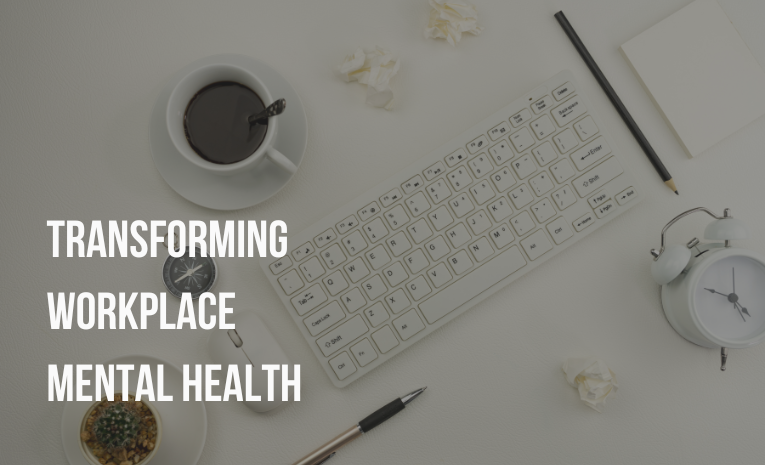5 Strategies for Transforming Workplace Mental Health
For many of us, the workplace constitutes a significant portion of our lives. We spend more waking hours in our physical or virtual workplace than at home, and our interactions with colleagues often outnumber those with family members. In today's world, it's crucial to recognize the impact of Workplace Mental Health on our overall well-being and to help combat the mental health crisis in America.
The Influence of Managers on Employee Mental Health
Recent findings from the Workforce Institute at UKG highlight the profound influence of managers on employee mental health. Surprisingly, managers can have a greater impact than therapists or general healthcare providers. In a survey, 60 percent of respondents identified their job as the most significant factor affecting their mental health.
Rising Challenges and Their Collective Impact
Rates of extreme stress, burnout, anxiety, depression, and substance use disorders are at record levels. Research from the Future Forum reveals that workplace stress is at an all-time high of 42% since spring 2021, with women and young people most at risk. The collective impact is also staggering. Studies show that every year, up to 200 million workdays in the US are lost due to mental health challenges. Untreated mental health conditions cost the United States upwards of $3.7 trillion every year.
Taking Action: 5 Steps to Improve Workplace Mental Health
Despite these challenges, many organizations and business leaders are taking proactive steps to address workplace mental health. Here are some strategies you can implement in your own workplace to improve conditions and increase mental health awareness:
1) Commit from the top
Some organizations have moved beyond just talking about mental health at work. They recognize that mental health directly affects business performance, innovation, and culture, making it a core pillar of their future-of-work strategy. Positive workplace mental health requires investment (time, intention, and action) from all levels of an organization, including leadership, management, and employees.
Over the past few years, the significance of centering employee’s mental health and wellbeing has become more evident and many organizational leaders are making these efforts a part of their companies’ attraction and retention programs. David Ko, CEO of Calm said, “CEOs have to rethink innovation to meet people where they are, with the tools they need in this new world. And, we have to be advocates for new policies, empower our employees, and set a clear vision and purpose for the future. This is where I see myself spending most of my time in 2023.”
2) Train people managers
If managers are acutely impacting the mental health of their employees, training them how to identify, understand, and respond to signs of mental illness in themselves and others is critical to change. Mental Health First Aid (MHFA) training can reduce the stigma surrounding mental illness by promoting understanding and empathy while helping managers recognize when an employee or colleague is experiencing a mental health crisis and take appropriate action to support them. It can also provide individuals with the tools to manage their own mental health and wellbeing, leading to improved productivity and quality of life.
3) Change policies and culture
According to McKinsey, recent global survey data suggest that improving workplace factors, such as eliminating toxic behaviors, boosting inclusivity, and creating sustainable workloads, can be more predictive of employee mental health and wellbeing than providing access to resources alone. Structural workplace changes that support better mental health for workers are becoming increasingly important as companies recognize the impact of mental health on productivity.
Additionally, understanding and addressing the six contributing factors to burnout and auditing your own team or company can be paramount in implementing successful mental health strategies. These factors go beyond just workload, including factors like control and autonomy, recognition and reward, community, fairness, and values. When there is a lack of or mismatch in these areas, burnout is much more likely to impact your workforce.
Business leaders and people managers can make small but impactful shifts in daily work culture. Here’s a few examples:
setting clear expectations and working norms
offering praise for work well done
ensuring the values of your team or organization are clear and aligned
providing quiet spaces for moments of quietude
4) Offer flexibility in working hours
The concept of a 4-day work week is gaining momentum around the world, and for good reason. Studies have shown that reducing the workweek from five to four days can lead to numerous benefits for both employees and employers. For workers, a shorter workweek can improve work-life balance, reduce stress levels, and increase job satisfaction. It also allows for more time to pursue personal interests, which can lead to increased creativity and innovation.
For employers, a 4-day work week can result in increased productivity, better employee retention rates, and lower overhead costs. Overall, the benefits of a 4-day work week are clear and it's a concept that more companies should consider implementing.
Additionally, employers can implement policies and programs that promote mental health explicitly, such as additional time off for mental health days and time off for therapy.
5) Advocate for yourself and others
Advocating for your mental health at work is crucial to maintaining and sustaining overall wellbeing. It involves open and honest communication about your needs, requesting reasonable accommodations when necessary, and setting clear boundaries to maintain healthy work-life harmony. Prioritizing self-care, including stress management techniques and mental health-promoting activities like therapy, is equally important. Advocacy not only fosters a better understanding of mental health in the workplace but also paves the way for a supportive, balanced, and productive work environment. Organizations like Mental Health Coalition have incredible resources on how to get the conversation started in your workplace.

